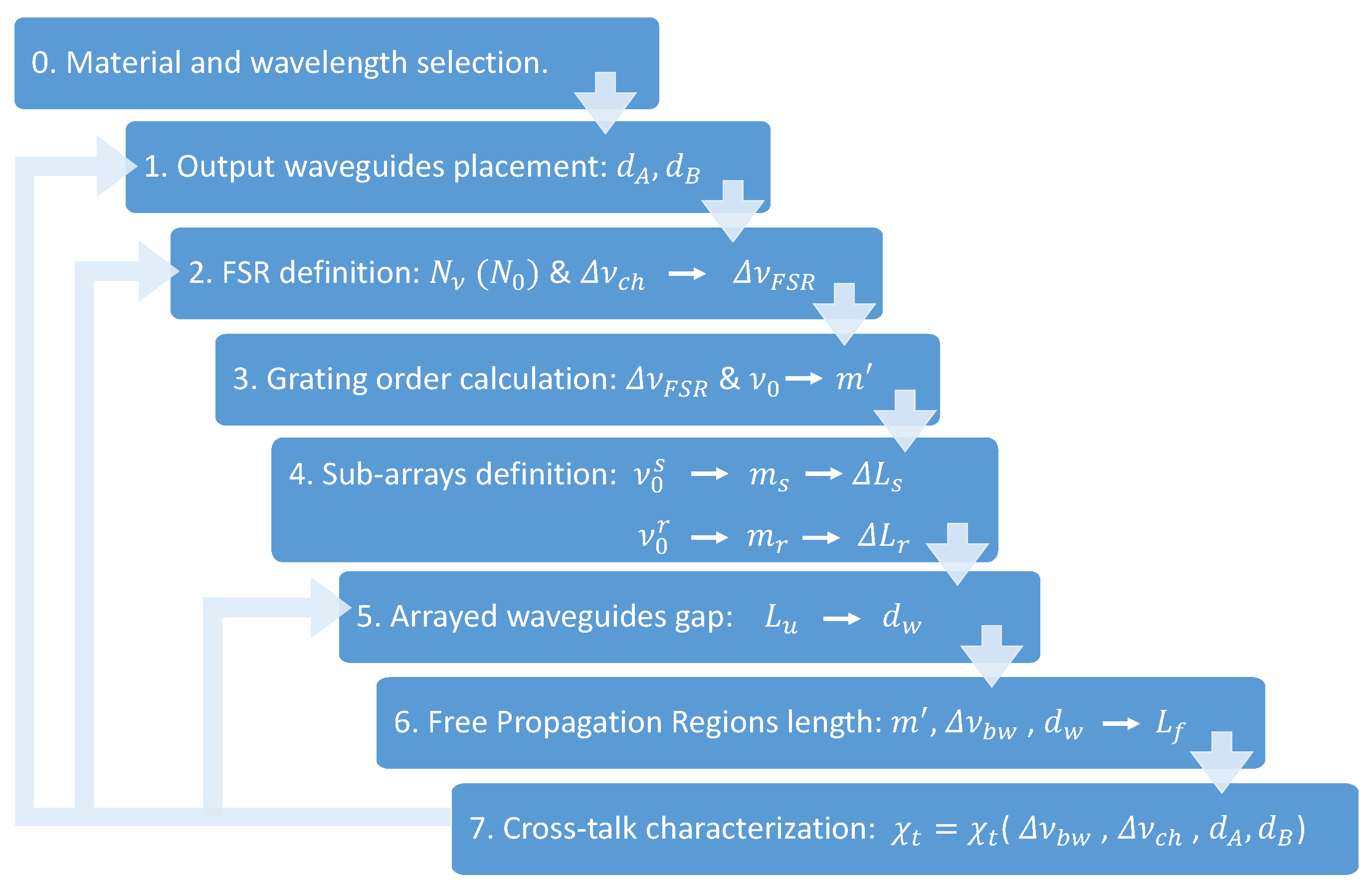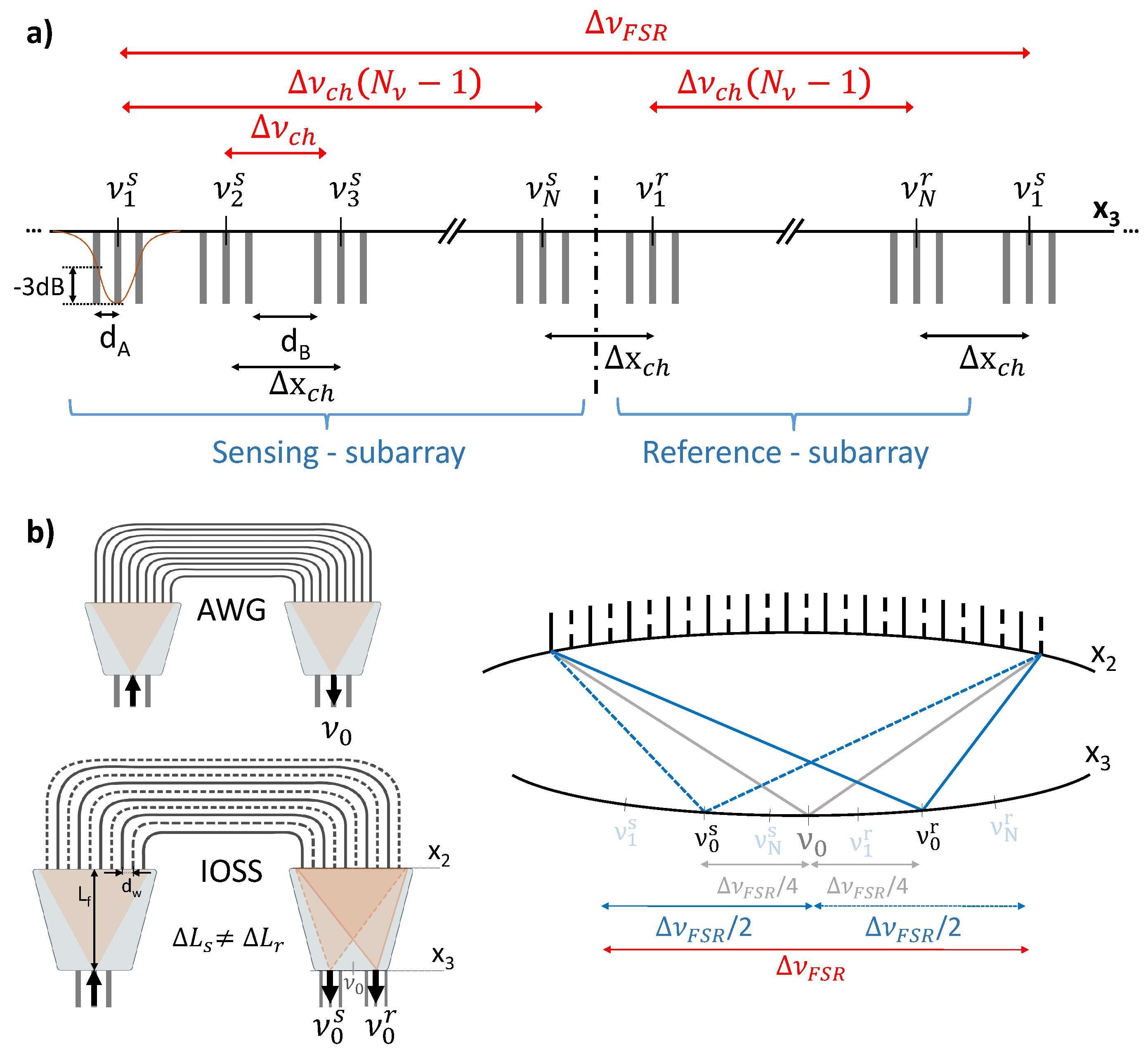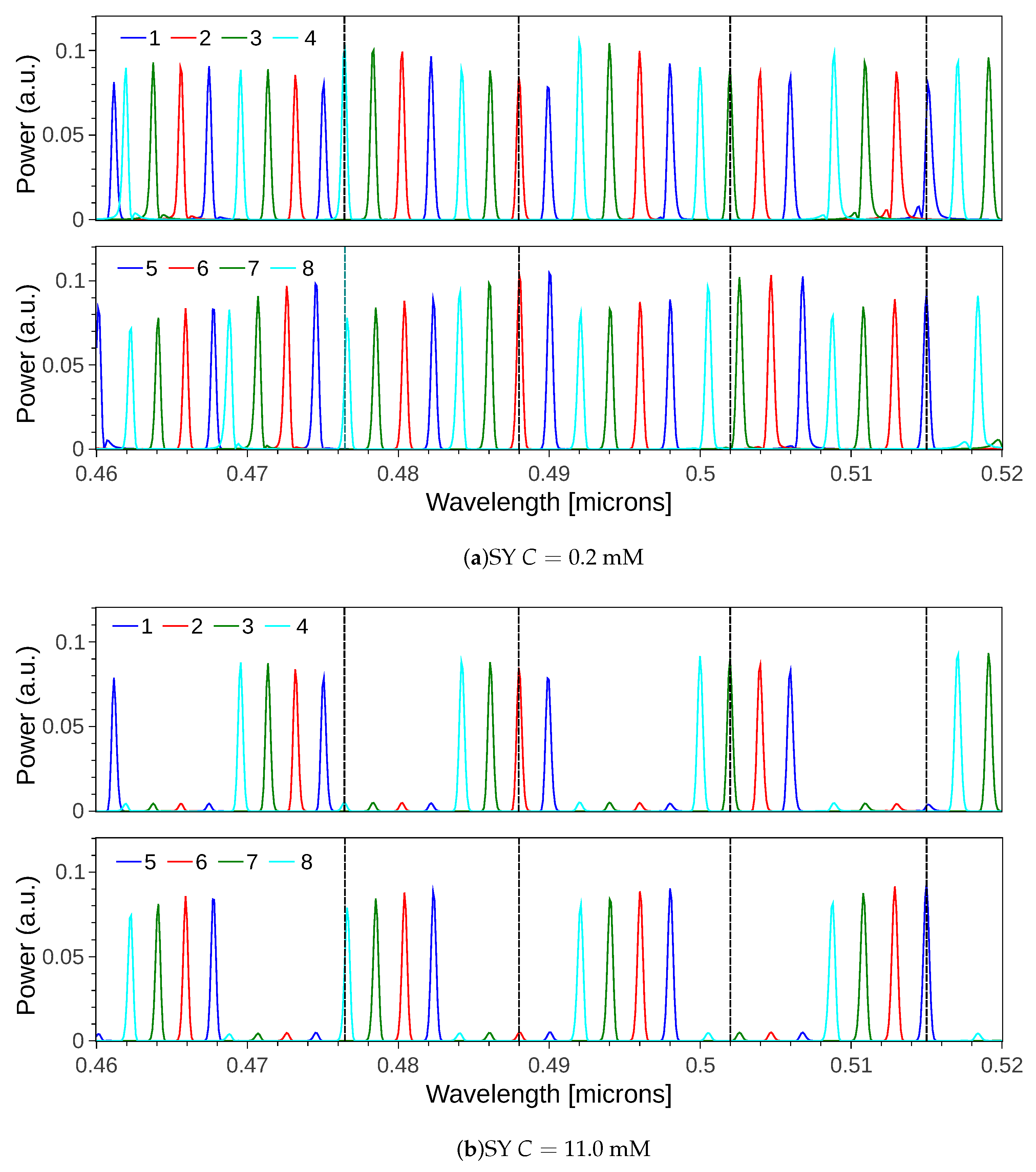Integrated Optic Sensing Spectrometer: Concept and Design
Abstract
:1. Introduction
2. Device Concept
3. Device Design
- , referred as central frequency (bandpass frequency between a pair of input and output waveguides),
- refractive indices of the FPR () and arrayed waveguides (),
- waveguides width () and mode field radius ().
- Number of channels (): number of wavelengths to analyze
- Frequency channel spacing (): frequency difference between adjacent channels
- Channel bandwidth (): range of frequencies transmitted through each channel
- Loss non uniformity (): amplitude signal relation between the central and most external output waveguide.
3.1. Readout Scheme: Output Waveguides Distances
3.2. Readout Scheme: Optical Frequencies
3.3. Focusing and Periodicity: Arm Spacing and FPR Length
4. Reference Designs
4.1. Visible Wavelength Range Device
4.2. Near Infrared Device
5. Conclusions
6. Patents
Author Contributions
Funding
Acknowledgments
Conflicts of Interest
References
- Willner, A.E.; Byer, R.L.; Chang-Hasnain, C.J.; Forrest, S.R.; Kressel, H.; Kogelnik, H.; Tearney, G.J.; Townes, C.H.; Zervas, M.N. Optics and photonics: Key enabling technologies. Proc. IEEE 2012, 100, 1604–1643. [Google Scholar] [CrossRef]
- Lim, A.E.J.; Song, J.; Fang, Q.; Li, C.; Tu, X.; Duan, N.; Chen, K.K.; Tern, R.P.C.; Liow, T.Y. Review of silicon photonics foundry efforts. IEEE J. Sel. Top. Quantum Elect. 2014, 20, 405–416. [Google Scholar] [CrossRef]
- Smit, M.; Leijtens, X.; Ambrosius, H.; Bente, E.; der Tol, J.; Smalbrugge, B.; De Vries, T.; Geluk, E.J.; Bolk, J.; Van Veldhoven, R.; et al. An introduction to {InP}-based generic integration technology. Semiconduct. Sci. Technol. 2014, 29, 83001. [Google Scholar] [CrossRef]
- Muñoz, P.; Micó, G.; Bru, L.A.; Pastor, D.; Pérez, D.; Doménech, J.D.; Fernández, J.; Baños, R.; Gargallo, B.; Alemany, R.; et al. Silicon Nitride Photonic Integration Platforms for Visible, Near-Infrared and Mid-Infrared Applications. Sensors 2017, 17, 2088. [Google Scholar] [CrossRef] [PubMed]
- Munoz, P. Photonic integration in the palm of your hand: Generic technology and multi-project wafers, technical roadblocks, challenges and evolution. In Proceedings of the 2017 Optical Fiber Communications Conference and Exhibition (OFC), Los Angeles, CA, USA, 19–23 March 2017; pp. 1–3. [Google Scholar]
- Lukosz, W.; Tiefenthaler, K. Directional switching in planar waveguides effected by adsorption-desorption processes. In Proceedings of the European Conference on Integrated Optics, Florence, Italy, 17–18 October 1983; pp. 152–155. [Google Scholar]
- Estevez, M.C.; Alvarez, M.; Lechuga, L.M. Integrated optical devices for lab-on-a-chip biosensing applications. Laser Photon. Rev. 2012, 6, 463–487. [Google Scholar] [CrossRef]
- Barrios, C.A. Integrated microring resonator sensor arrays for labs-on-chips. Anal. Bioanal. Chem. 2012, 403, 1467–1475. [Google Scholar] [CrossRef] [PubMed]
- Movassaghi, S.; Abolhasan, M.; Lipman, J.; Smith, D.; Jamalipour, A. Wireless body area networks: A survey. IEEE Commun. Surv. Tutor. 2014, 16, 1658–1686. [Google Scholar] [CrossRef]
- Baird, W.; Nogar, N.S. Compact, Self-Contained optical spectrometer. Appl. Spectrosc. 1995, 49, 1699–1704. [Google Scholar] [CrossRef]
- Norris, K. Performance Criteria for the Choice of Compact Spectrometers; White Paper; Horiba Scientific UK Ltd.: Stanmore, UK, 2013. [Google Scholar]
- Feng, D.; Qian, W.; Liang, H.; Kung, C.C.; Fong, J.; Luff, B.J.; Asghari, M. Fabrication insensitive echelle grating in silicon-on-insulator platform. IEEE Photon. Technol. Lett. 2011, 23, 284–286. [Google Scholar] [CrossRef]
- Takahashi, H.; Suzuki, S.; Nishi, I. Wavelength multiplexer based on SiO/sub 2/-Ta/sub 2/O/sub 5/arrayed-waveguide grating. J. Lightwave Technol. 1994, 12, 989–995. [Google Scholar] [CrossRef]
- Munoz, P.; Pastor, D.; Capmany, J. Modeling and Design of Arrayed Waveguide Gratings. J. Lightwave Technol. 2002, 20, 661. [Google Scholar] [CrossRef]
- Kodate, K.; Komai, Y. Compact spectroscopic sensor using an arrayed waveguide grating. J. Opt. A Pure Appl. Opt. 2008, 10, 044011. [Google Scholar] [CrossRef]
- Subramanian, A.Z.; Ryckeboer, E.; Dhakal, A.; Peyskens, F.; Malik, A.; Kuyken, B.; Zhao, H.; Pathak, S.; Ruocco, A.; De Groote, A.; et al. Silicon and silicon nitride photonic circuits for spectroscopic sensing on-a-chip [Invited]. Photonics Res. 2015, 3, B47. [Google Scholar] [CrossRef]
- Doerr, C.R. Proposed {WDM} cross connect using a planar arrangement of waveguide grating routers and phase shifters. IEEE Photonics Technol. Lett. 1998, 10, 528–530. [Google Scholar] [CrossRef]
- Doerr, C.R.; Zhang, L.; Winzer, P.J. Monolithic InP Multiwavelength Coherent Receiver Using a Chirped Arrayed Waveguide Grating. J. Lightwave Technol. 2011, 29, 536–541. [Google Scholar] [CrossRef]
- Gargallo, B.; Muñoz, P. Full field model for interleave-chirped arrayed waveguide gratings. Opt. Express 2013, 21, 6928–6942. [Google Scholar] [CrossRef] [PubMed]
- Ryckeboer, E.; Nie, X.; Dhakal, A.; Martens, D.; Bienstman, P.; Roelkens, G.; Baets, R. Spectroscopic sensing and applications in Silicon Photonics. In Proceedings of the IEEE 14th International Conference on Group IV Photonics (GFP), Berlin, Germany, 23–25 August 2017; pp. 4–5. [Google Scholar]
- Zhao, H.; Clemmen, S.; Raza, A.; Baets, R. Stimulated Raman spectroscopy of analytes evanescently probed by a silicon nitride photonic integrated waveguide. Opt. Lett. 2018, 43, 1403–1406. [Google Scholar] [CrossRef] [PubMed]
- Vasiliev, A.; Muneeb, M.; Allaert, J. Integrated Silicon-on-Insulator Spectrometer With Single Pixel Readout for Mid-Infrared Spectroscopy. IEEE J. Sel. Top. Quantum Electron. 2018, 24. [Google Scholar] [CrossRef]
- Ryckeboer, E.; Bockstaele, R.; Vanslembrouck, M.; Baets, R. Glucose sensing by waveguide-based absorption spectroscopy on a silicon chip. Biomed. Opt. Express 2014, 5, 12356–12364. [Google Scholar] [CrossRef] [PubMed]
- Smit, M.K.; van Dam, C. PHASAR-Based WDM-Devices: Principles, Design and Applications. IEEE J. Sel. Top. Quantum Electron. 1996, 2, 236–250. [Google Scholar] [CrossRef]
- Pozo, J.; Westerveld, W.; Harmsma, P.J.; Yang, S.; Bodis, P.; Nieuwland, R.; Lagioia, M.; Cascio, D.M.R.L.; Staats, J.P.; Schmits, R.; et al. Silicon on insulator photonic integrated sensors: On-chip sensing and interrogation. In Proceedings of the 2011 13th International Conference on Transparent Optical Networks, Stockholm, Sweden, 26–30 June 2011; pp. 1–4. [Google Scholar] [CrossRef]
- Muñoz, P.; Pastor, D.; Capmany, J.; Martínez, A. Geometrical optimization of the transmission and dispersion properties of arrayed waveguide gratings using two stigmatic point mountings. Opt. Express 2003, 11, 2425–2432. [Google Scholar] [CrossRef] [PubMed]
- Coultate, T.P. Food: The Chemistry of Its Components; Royal Society of Chemistry: London, UK, 2009; Chapter 6; pp. 214–267. [Google Scholar]
- Gomes, K.M.S.; de Oliveira, M.V.G.A.; Carvalho, F.R.d.S.; Menezes, C.C.; Peron, A.P. Citotoxicity of food dyes sunset yellow (E-110), bordeaux red (E-123), and tatrazine yellow (E-102) on Allium cepa L. root meristematic cells. Food Sci. Technol. 2013, 33, 218–223. [Google Scholar] [CrossRef]
- Horowitz, V.R.; Janowitz, L.A.; Modic, A.L.; Heiney, P.A.; Collings, P.J. Aggregation behavior and chromonic liquid crystal properties of an anionic monoazo dye. Phys. Rev. E 2005, 72, 41710. [Google Scholar] [CrossRef] [PubMed]
- Jiménez-Márquez, F.; Vázqueza, J.; Úbedab, J.; Rodríguez-Reya, J.; Sánchez-Rojasa, J.L. Optoelectronic sensor device for monitoring ethanol concentration in winemaking applications. Proc. SPIE 2015, 9517. [Google Scholar] [CrossRef]
- Kakuta, N.; Yamashita, H.; Kawashima, D.; Kondo, K.; Arimoto, H.; Yamada, Y. Simultaneous imaging of temperature and concentration of ethanol-water mixtures in microchannel using near-infrared dual-wavelength absorption technique. Meas. Sci. Technol. 2016, 27, 12. [Google Scholar] [CrossRef]








© 2019 by the authors. Licensee MDPI, Basel, Switzerland. This article is an open access article distributed under the terms and conditions of the Creative Commons Attribution (CC BY) license (http://creativecommons.org/licenses/by/4.0/).
Share and Cite
Micó, G.; Gargallo, B.; Pastor, D.; Muñoz, P. Integrated Optic Sensing Spectrometer: Concept and Design. Sensors 2019, 19, 1018. https://doi.org/10.3390/s19051018
Micó G, Gargallo B, Pastor D, Muñoz P. Integrated Optic Sensing Spectrometer: Concept and Design. Sensors. 2019; 19(5):1018. https://doi.org/10.3390/s19051018
Chicago/Turabian StyleMicó, Gloria, Bernardo Gargallo, Daniel Pastor, and Pascual Muñoz. 2019. "Integrated Optic Sensing Spectrometer: Concept and Design" Sensors 19, no. 5: 1018. https://doi.org/10.3390/s19051018




